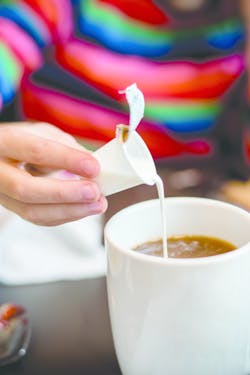What does coffee look like in 2017? It depends a lot on the age of the drinker, but there have been some interesting trends. Despite the rise in consumers learning about coffee, such as what makes quality beans, which areas of the world are known for great coffee or how the roasting process works, there are still many people who don’t drink their coffee unadorned or black. Unadorned is the way many passionate coffee lovers believe coffee should be experienced to truly get the flavor, but that hasn’t stopped the rapid growth of specialty drinks or different options to add to the morning cup of joe. In fact, most people in the US add something to their coffee.
According to the latest National Coffee Association’s National Coffee Drinking Trends (NCDT) report, 68 percent of coffee drinkers whiten their coffee, using some form of creamer, half and half, milk or non-dairy milk alternative. Creamer is the designation given to the whitener used most often, with 35 percent of drinkers adding this type of whitener. Half and half came in second, over whole milk by a slim margin of 14 percent for the former, compared to 13 percent. The last option, dairy milk alternative, has just begun to move the needle as far as common coffee whiteners, but its gaining.
Creamer and flavoring trends
This was the first year the NCDT asked expanded questions about non-dairy milk alternatives. Those questions revealed that a surprising 5 percent of drinkers used this type of whitener. BevNET reports tthat suppliers of these non-dairy alternatives are finding an increasing demand from coffee drinkers. During an interview Brian Lovejoy, coffee general manager at Califia Farms, mentioned that consumers were asking at coffee shops for non-dairy alternatives. This was a untapped market that companies such as Califia Farms started to tap into, working with Baristas to create even more non-dairy options. The popularity of items such as Almond milk is strong as it blends equally well hot or cold, including with cold brew.
Interestingly, when flavoring was added to coffee, it was most often done as a powder or liquid creamer, 21 percent, rather than by itself, which happened with only 5 percent of consumers. While flavored creamers were once innovating the creamer market, the so called “clean label” creamers are now the most significant trend. Last year, Packaged Facts called creamers that boast natural ingredients as essential to US retail growth in the creamer industry, especially among premium priced varieties. Plant-based creamers also fell into this category, with Packaged Facts reporting “strong growth in the almond milk segment is the single most significant development in market trends.”
Sweeteners
Just over half of coffee drinkers also sweeten their coffee. Sugar was the clear favorite, according to the NCDT, with 38 percent of drinkers reportedly adding it to their past-day coffee. Artificial sweeteners were the next most popular with 12 percent.
While the arguments of sugar versus sweetener continue to rage, especially when clean label and natural considerations come into the mix, it is clear that consumers prefer things sweeter than 40 years ago. According to Pew Research Center, sugar and sweeteners accounted for nearly 400 calories per day in 2010, compared to just over 300 in 1970. While sugar consumption peaked in 1999 and has since declined, it is still higher than years ago thanks to the sweet tooth of consumers.
In the end, office coffee service is taking on a new challenge — competing with the corner coffeeshop. If having great workplace coffee is an important benefit for the location, it is important to start offering the coffee additives most in demand to more than half of coffee drinkers. This is a must in order to stay relevant. That means the right mix of whitener options from dairy to alternative as well as sugar and other sweeteners that allow consumers to truly make their coffee their own.
About the Author

Emily Refermat
Emily Refermat began covering the vending industry in 2006 and served as editor of Automatic Merchandiser from 2012 to 2019. To reach the current editor of Automatic Merchandiser and VendingMarketWatch.com, email [email protected].
